[Update: I hope the presentations from the speakers are posted, as they were all inspiring in their different ways. Bristol City Council's civic crowdsourcing projects had impressive participation rates, and Phil Higgins identified the critical success factors as: choose the right platform, use it at the right stage, issue must be presented clearly. Joanne Orr talked about museum contexts that are encapsulating the intangible including language and practices (and recording intangible cultural heritage in a wiki) and I could sense the audience's excitement about Andrew Ellis' presentation on 'Your Paintings' and the crowdsourcing tagger developed for the Public Catalogue Foundation.]
I'm in Edinburgh for the Museums Galleries Scotland conference 'Collaborating to Compete'. I'm chairing a session on 'Entrepreneurship and Social Media'. In this context, the organisers defined entrepreneurship as 'doing things innovatively and differently', including new and effective ways of working. This session is all about working in partnerships and collaborating with the public. The organisers asked me to talk about my own research as well as introducing the session. I'm posting my notes in advance to save people having to scribble down notes, and I'll try to post back with notes from the session presentations.
Welcome to this session on entrepreneurship and social media. Our speakers are going to share their exciting work with museum collections and cultural heritage. Their projects demonstrate the benefits of community participation, of opening up to encourage external experts to share their knowledge, and of engaging the general public with the task of improving access to cultural heritage for all. The speakers have explored innovative ways of working, including organisational partnerships and low-cost digital platforms like social media. Our speakers will discuss the opportunities and challenges of collaborating with audiences, the issues around authority, identity and trust in user-generated content, and they'll reflect on the challenges of negotiating partnerships with other organisations or with 'the crowd'.
You'll hear about two different approaches to crowdsourcing from Phil Higgins and Andy Ellis, and about how the 'Intangible Cultural Heritage' project helps a diverse range of people collaborate to create knowledge for all.
I'll also briefly discuss my own research into crowdsourcing through games as an example of innovative forms of participation and engagement.
If you're not familiar with the term, crowdsourcing generally means sharing tasks with the public that are traditionally performed in-house.
Until I left to start my PhD, I worked at the Science Museum in London, where I spent a lot of time thinking about how to make the history of science and technology more engaging, and the objects related to it more accessible. This inspired me when I was looking for a dissertation project for my MSc, so I researched and developed 'Museum Metadata Games' to explore how crowdsourcing games could get people to have fun while improving the content around 'difficult' museum objects.
Unfortunately (most) collections sites are not that interesting to the general public. There's a 'semantic gap' between the everyday language of the public and the language of catalogues.
Projects like steve.museum showed crowdsourcing helps, but it can be difficult to get people to participate in large numbers or over a long period of time. Museums can be intimidating, and marketing your project to audiences can be expensive. But what if you made a crowdsourcing interface that made people want to use it, and to tell their friends to use it? Something like… a game?
A lot of people play games… 20 million people in the UK play casual games. And a lot of people play museum games. Games like the Science Museum's Launchball and the Wellcome Collection's High Tea have had millions of plays.
Crowdsourcing games are great at creating engaging experiences. They support low barriers to participation, and the ability to keep people playing. As an example, within one month of launching, DigitalKoot, a game for National Library of Finland, had 25,000 visitors complete over 2 million individual tasks.
Casual game genres include puzzles, card games or trivia games. You've probably heard of Angry Birds and Solitaire, even if you don’t think of yourself as a 'gamer'.
Casual games are perfect for public participation because they're designed for instant gameplay, and can be enjoyed in a few minutes or played for hours.
Easy, feel-good tasks will help people get started. Strong game mechanics, tested throughout development with your target audience, will motivate on-going play and keep people coming back.
Here’s a screenshot of the games I made.
In the tagging game 'Dora's lost data', the player meets Dora, a junior curator who needs their help replacing some lost data. Dora asks the player to add words that would help someone find the object shown in Google.
When audiences can immediately identify an activity as a game – in this the use of characters and a minimal narrative really helped – their usual reservations about contributing content to a museum site disappear.
The brilliant thing about game design is that you can tailor tasks and rewards to your data needs, and build tutorials into gameplay to match the player’s skills and the games’ challenges.
Fun is personal – design for the skills, abilities and motivations of your audience.
People like helping out – show them how their data is used so they can feel good about playing for a few minutes over a cup of tea.
To conclude, crowdsourcing games can be fun and useful for the public and for museums. And now we're going to hear more about working with the public… [the end!]
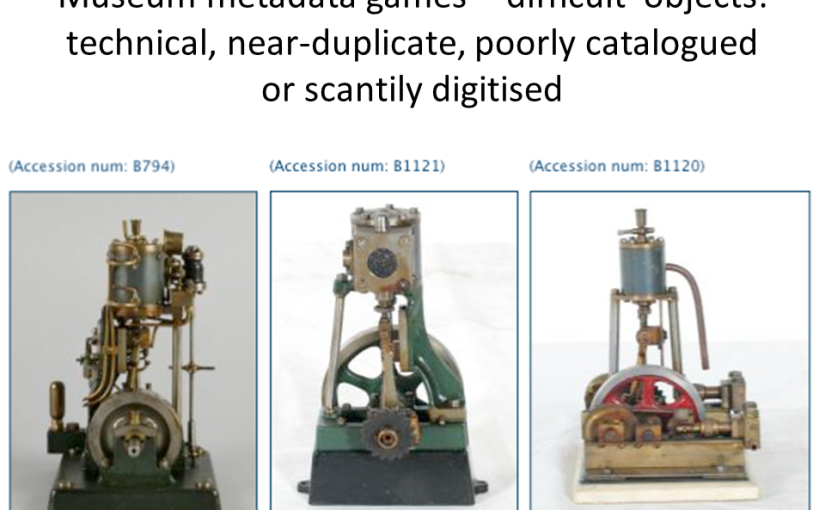

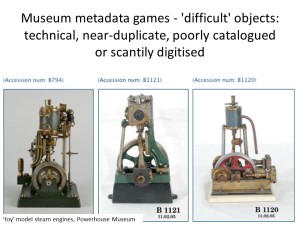
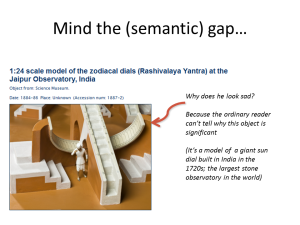
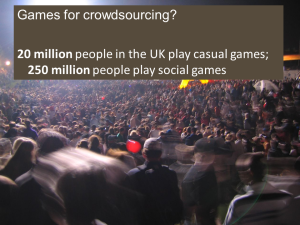
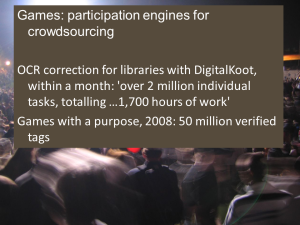
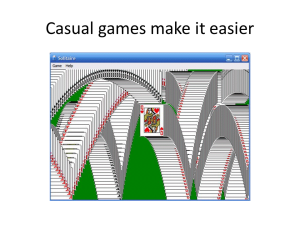
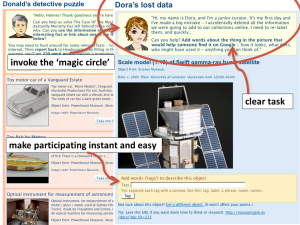
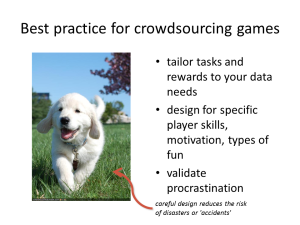
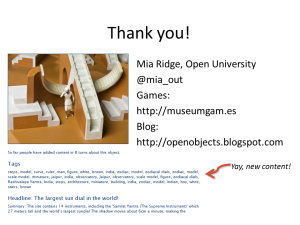
3 thoughts on “'Entrepreneurship and Social Media' and 'Collaborating to Compete'”